Photography by Cameron Lawson
I don’t like to be cold.
I’m afraid of the dark. And I’m not a camper.
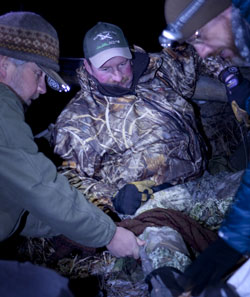 Perry Brown, playing the role of a passenger injured in an aircraft accident, gets a broken leg splinted by Wade Cebulski.
Perry Brown, playing the role of a passenger injured in an aircraft accident, gets a broken leg splinted by Wade Cebulski.
That’s why I’m panicking as my first three attempts to start a fire with my flint and steel fail. It’s dark—the temperature is in the teens with gusty winds and flurries—and I’ll be spending the night outside, alone, in northwestern Montana in the middle of winter in a tarpaulin-and-pine-branch hut that I built. The fire is supposed to be my source of heat, my security blanket.
I enrolled in the Surratt Memorial Winter Survival Clinic, designed by David Hoerner, safety and education program manager for the Montana Department of Transportation’s Aeronautics Division, to learn how to survive in the wilderness until rescue arrives—which could be days depending on the terrain and weather conditions. Until now, my emergency training focused on flying the aircraft; many simulated forced-landing scenarios occurred over large fields with a farmer’s house nearby—a by-product of learning to fly in agricultural areas of Ohio and western West Virginia. Now I occasionally fly across the remote terrain of the Appalachian Mountains. What I usually carry in the aircraft—a bottle of water, crackers, flashlight, Leatherman tool, and my cellphone—wouldn’t be of much help after a few hours.
Live out of your pack
Assembling a survival kit would be a good first step. Retired Army Special Forces Master Sgt. Frank Bowen, an instructor at the clinic, encourages participants to “pack the things you would normally put in your personal and/or airframe survival pack.” For inexperienced survivalists, he includes a suggested equipment list with questions to make participants think about what’s needed to start a fire, build a shelter, purify water, and signal for help. Commercial prepackaged survival kits are available, but I wanted to see how much I could assemble from scratch.
After raiding the emergency kit in my car, gathering first-aid supplies, and grabbing a Paula Deen saucepan from my kitchen (to use for boiling water or digging snow), I still lacked anything to start a fire, chop wood, or sleep outdoors. I bought a flint-and-steel fire-starter set, cotton balls, petroleum jelly, water purification tablets, rope, tarp, a sleeping bag, thermal mat, and a machete. As for clothing, Bowen suggested, “Go with what your mama told you if nothing else. Layers of clothing are good. Too much sweat is just as bad as getting rained on or taking an unexpected swim.”
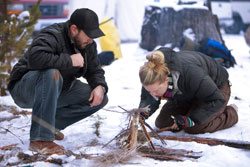 A husband and wife—both pilots—work together to learn lifesaving techniques.
A husband and wife—both pilots—work together to learn lifesaving techniques.
Because I’m an aircraft renter, my survival kit needs to be portable, fit into different types of aircraft, and be within my reach in the cockpit; I wouldn’t want to forget it in the baggage compartment. All of the supplies—except for the sleeping bag, thermal mat, and machete—fit into or strap onto my backpack.
Some pilots who regularly fly over the rugged backcountry wear their survival kits in the cockpit. John and Tricia McKenna, president and administrative director of the Recreational Aviation Foundation, who had recommended the winter clinic, wear survival vests. This decreases the chances that the kit will be forgotten in the aircraft or burned in the wreckage before you can remove it; plus, it’s already on you in case injuries limit your mobility. Vests can be purchased prefilled with survival supplies, or a simple fishing vest can serve as the base. What matters, according to Bowen, is to do “what fits your style.”
Not a weekend vacation
Thirty-three participants met instructors in Marion, where Hoerner, a 30,000-plus hour pilot who has made 16 forced landings, discussed emergency procedures. Flathead County Sheriff Chuck Curry—who has responded to 20 aircraft accidents—presented a brief lecture on survival medicine before the course’s first challenge began. The evening’s scenario: A single-engine aircraft has crashed in the Montana wilderness, all four on board are injured, and help won’t arrive for 36 hours. We, in turn, must practice injury assessment and keep the passengers safe and as comfortable as possible.
 A flare gun, signal mirror, CD, flashing beacon, or smoke signal can catch a searcher's attention.
A flare gun, signal mirror, CD, flashing beacon, or smoke signal can catch a searcher's attention.
The weekend-long clinic is designed to give participants hands-on experience through real-world scenarios so that the training will kick in during an actual emergency. In this case, injuries range from broken bones to possible concussions. Curry counsels us to remain calm, use common sense, and treat injuries with whatever resources are available. A scarf and branches serve as a splint. Break the situation down and address it step by step, Curry said, using the ABCs—airway, breathing, circulation, and disability. During the assessments, we learn the importance of involving those who are injured but conscious in problem solving: It’ll make it easier to get them to work through the pain to perform a task, such as moving to a safer location, if they have input.
Even though nighttime temperatures dropped into the teens—mild for northwestern Montana in January—the cold posed little threat. Bowen says we could have rolled up in a tarpaulin outside and lived through the night. His words provide little comfort as I crawl into the iced-over fuselage of a Beechcraft Musketeer, where I will spend the first night of the clinic with Donne Rossow, a student from Rocky Mountain College in Billings who thought the course would be “more of a vacation because I’m used to it.”
We lay shoulder to shoulder in the Musketeer—sans the wings, horizontal stabilizer, everything forward of the firewall, seats, controls, and instrument panel—and the cabin door refuses to stay shut. Rossow absorbs more of the draft because she is beside the door in a gunny sack. Tucked inside my mummy sleeping bag, I stay warm on the walled side of the cabin. Still, the experience is no vacation. “I really hope I never have to sleep in one again,” Rossow said. “At least we’re going to know what to expect—a poor, cold night’s sleep.”
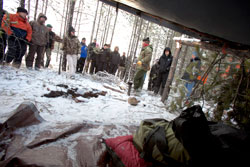 Faced with spending the night outside in northern Montana in the middle of winter provides incentive for pilots to quickly build survival shelters, ranging from simple tarp-and-rope constructions to elaborate four-man rustic condominiums.
Faced with spending the night outside in northern Montana in the middle of winter provides incentive for pilots to quickly build survival shelters, ranging from simple tarp-and-rope constructions to elaborate four-man rustic condominiums.
Plan of action
Each emergency survival situation is different, depending on injuries, terrain, climate, and time until rescue; all those factors can alter your plan of action. Fire, shelter, water, and rescue signals are imperative; the order could be dictated by the circumstances. In the winter, fire should be one of the top priorities.
Instructors recommend carrying more than one type of fire starter. Lighters provide a constant flame, but they don’t always work at elevation, can run dry, and can break, Bowen said. Flint and steel, or stormproof matches, are small and lightweight, perfect for packing in a survival kit. Before starting the fire, gather all of the types of wood needed to keep it burning (mine extinguished each of the three times I left to gather more wood), either by scavenging the ground or searching for dead-but-still-attached tree limbs. “It’s pretty useful to be able to rip branches off trees left and right and start a fire,” said Riley Boyd, an A&P mechanic and private pilot from Springfield, Illinois, who is completing his first year at Rocky Mountain College. Useful, yes, but it feels empowering, too—especially for someone who’s never started a fire before in the wilderness.
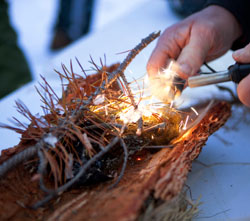 Sparks from a flint-and-steel set can light tinder.
Sparks from a flint-and-steel set can light tinder.
The fire and shelter should be located near the aircraft wreckage because that’s where rescuers will come. A man-made shelter can be as simple as a tarpaulin draped over a rope (or wiring from the aircraft) between trees or as elaborate as a four-man hut. Pine boughs added to the sides provide extra protection from the wind, and they can serve as cushioning and insulation from the cold ground or snow. While building the shelter, keep in mind the amount of energy being expended; the body already is burning more calories just to stay warm and food supplies could be limited. I worked up a sweat while I tried to chop down a sapling with my machete—the act took much longer than it should have because I could not hit the same area twice.
The aircraft fuselage also can serve as a shelter, and in some cases—particularly if injuries limit mobility—it may be the only option.
Water purification is crucial because, as Bowen put it, when you are in a survival hut, you don’t want a case of diarrhea. After spending most of the weekend outside, Bowen’s words couldn’t ring truer. A fireproof container or parts of the aircraft, such as the spinner, could be used to gather snow for melting. If water is nearby, a filter and purification tablets, or a few drops of chlorine bleach, can make the water potable, Bowen said.
Hopefully rescuers already are looking for you while you assess your passengers for injuries and begin your plan of action. Double check that the aircraft’s emergency locator transmitter and any personal locator beacons have been activated. A handheld radio or cellphone could be used to contact help or send signals. If all else fails, turn to the basics—smoke and mirror signals, or flare guns. Signal mirrors (a CD works the same way) allow you to look through a tiny hole to see the rescue aircraft to ensure you are flashing it in the right location. Or, stick your free hand in the air, in line with the aircraft you are targeting, and angle the signal mirror so that it flashes across your hand. This will allow you to know the direction of the signal.
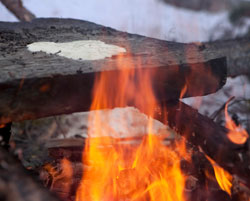 As a test of creativity, pilots must figure out how to cook a pancake over an open flame.
As a test of creativity, pilots must figure out how to cook a pancake over an open flame.
Smoke signals also grab the attention of searchers. During the clinic, instructors piled fresh pine boughs three feet high and lit them with a flaming, loosely wadded ball of duct tape. Soon, a thick stream of white smoke poured from the pile. “That kind of makes that duct tape like the world’s greatest thing, doesn’t it?” Bowen said. He recommended creating three piles in a triangle and lighting them in stages for the longest, continuous stream of smoke.
Trial run
These techniques are easier said than done. My confidence grew throughout the course as I achieved new personal firsts. Now that I’m solo, trying to start a fire on my own with no other course participants within 50 yards to help, fears and doubts fill my mind. What if I can’t get my fire started? How will I survive the night? I sit back, take a deep breath, and remember the words of Doug Dryden, a game warden and course instructor: “Your mindset, that’s what keeps you alive—more so than your gun or anything else.” After a few more sparks from the flint and steel, my fire catches. It’s as comforting as a friend. As I crawl into my survival hut, I tuck my machete under the edge. It’s going to be a long night, but I know I can do it. I’ve trained for it.
For more information, contact the Montana Department of Transportation’s Aeronautics Safety and Education Program Manager David Hoerner at dhoerner@mt.gov.
Email the author at alyssa.miller@aopa.org.
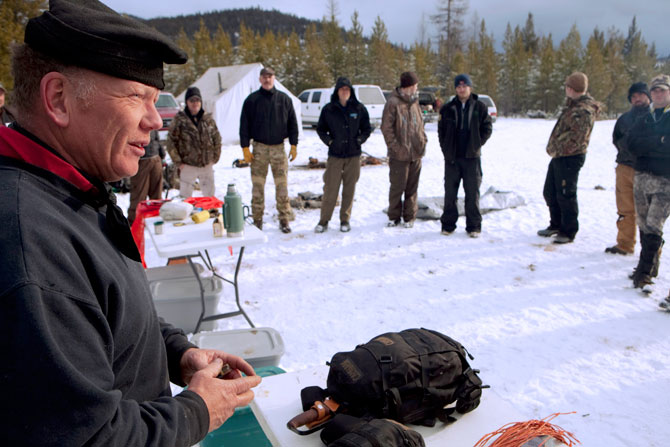
A weekend outdoors in the Montana wilderness during a winter survival clinic is no vacation, but what you learn can save your life after an accident.
Accident reinforced importance of survival skills
Terry Surratt was flying home over Montana’s mountainous terrain at night, in instrument meteorological conditions, when his airplane accumulated ice and went down near Garrison. He survived the January 29, 1992, accident, but not the bitter winter environment.
Deb Myers, Surratt’s widow, said her husband did not have survival training and that his idea of camping was staying in a bad hotel. Myers used donations after the accident to help the Montana Department of Transportation’s Aeronautics Division relaunch its survival clinic that had been cut during difficult financial times. “I felt that it was something that was worthwhile,” said AOPA Representative Mike Ferguson, who headed the aeronautics division at the time. “I’ve been through it lots of times. I always learned something.” The clinic still carries the Surratt name.
Myers and her two children have since taken the survival course. “I came out of the course with the skills to build a shelter,” Myers said of her experience at the clinic in 2007, after her second husband was killed in an automobile accident. She also learned a personal lesson: “That I was going to be OK.” —AJM



